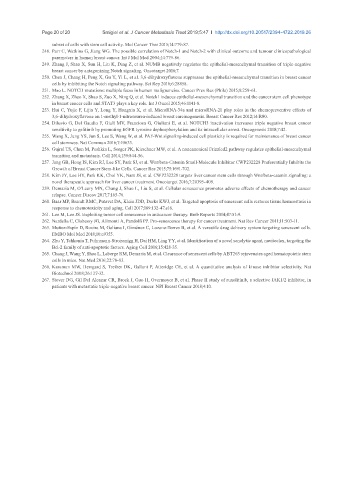Page 355 - Read Online
P. 355
Page 20 of 20 Smigiel et al. J Cancer Metastasis Treat 2019;5:47 I http://dx.doi.org/10.20517/2394-4722.2019.26
subset of cells with stem cell activity. Mol Cancer Ther 2015;14:779-87.
248. Parr C, Watkins G, Jiang WG. The possible correlation of Notch-1 and Notch-2 with clinical outcome and tumour clinicopathological
parameters in human breast cancer. Int J Mol Med 2004;14:779-86.
249. Zhang J, Shao X, Sun H, Liu K, Ding Z, et al. NUMB negatively regulates the epithelial-mesenchymal transition of triple-negative
breast cancer by antagonizing Notch signaling. Oncotarget 2016;7.
250. Chen J, Chang H, Peng X, Gu Y, Yi L, et al. 3,6-dihydroxyflavone suppresses the epithelial-mesenchymal transition in breast cancer
cells by inhibiting the Notch signaling pathway. Sci Rep 2016;6:28858.
251. Mao L. NOTCH mutations: multiple faces in human malignancies. Cancer Prev Res (Phila) 2015;8:259-61.
252. Zhang X, Zhao X, Shao S, Zuo X, Ning Q, et al. Notch1 induces epithelial-mesenchymal transition and the cancer stem cell phenotype
in breast cancer cells and STAT3 plays a key role. Int J Oncol 2015;46:1141-8.
253. Hui C, Yujie F, Lijia Y, Long Y, Hongxia X, et al. MicroRNA-34a and microRNA-21 play roles in the chemopreventive effects of
3,6-dihydroxyflavone on 1-methyl-1-nitrosourea-induced breast carcinogenesis. Breast Cancer Res 2012;14:R80.
254. Diluvio G, Del Gaudio F, Giuli MV, Franciosa G, Giuliani E, et al. NOTCH3 inactivation increases triple negative breast cancer
sensitivity to gefitinib by promoting EGFR tyrosine dephosphorylation and its intracellular arrest. Oncogenesis 2018;7:42.
255. Wang X, Jung YS, Jun S, Lee S, Wang W, et al. PAF-Wnt signaling-induced cell plasticity is required for maintenance of breast cancer
cell stemness. Nat Commun 2016;7:10633.
256. Gujral TS, Chan M, Peshkin L, Sorger PK, Kirschner MW, et al. A noncanonical Frizzled2 pathway regulates epithelial-mesenchymal
transition and metastasis. Cell 2014;159:844-56.
257. Jang GB, Hong IS, Kim RJ, Lee SY, Park SJ, et al. Wnt/beta-Catenin Small-Molecule Inhibitor CWP232228 Preferentially Inhibits the
Growth of Breast Cancer Stem-like Cells. Cancer Res 2015;75:1691-702.
258. Kim JY, Lee HY, Park KK, Choi YK, Nam JS, et al. CWP232228 targets liver cancer stem cells through Wnt/beta-catenin signaling: a
novel therapeutic approach for liver cancer treatment. Oncotarget 2016;7:20395-409.
259. Demaria M, O'Leary MN, Chang J, Shao L, Liu S, et al. Cellular senescence promotes adverse effects of chemotherapy and cancer
relapse. Cancer Discov 2017;7:165-76.
260. Baar MP, Brandt RMC, Putavet DA, Klein JDD, Derks KWJ, et al. Targeted apoptosis of senescent cells restores tissue homeostasis in
response to chemotoxicity and aging. Cell 2017;169:132-47.e16.
261. Lee M, Lee JS. Exploiting tumor cell senescence in anticancer therapy. Bmb Reports 2014;47:51-9.
262. Nardella C, Clohessy JG, Alimonti A, Pandolfi PP. Pro-senescence therapy for cancer treatment. Nat Rev Cancer 2011;11:503-11.
263. Muñoz-Espín D, Rovira M, Galiana I, Giménez C, Lozano-Torres B, et al. A versatile drug delivery system targeting senescent cells.
EMBO Mol Med 2018;10:e9355.
264. Zhu Y, Tchkonia T, Fuhrmann-Stroissnigg H, Dai HM, Ling YY, et al. Identification of a novel senolytic agent, navitoclax, targeting the
Bcl-2 family of anti-apoptotic factors. Aging Cell 2016;15:428-35.
265. Chang J, Wang Y, Shao L, Laberge RM, Demaria M, et al. Clearance of senescent cells by ABT263 rejuvenates aged hematopoietic stem
cells in mice. Nat Med 2016;22:78-83.
266. Karaman MW, Herrgard S, Treiber DK, Gallant P, Atteridge CE, et al. A quantitative analysis of kinase inhibitor selectivity. Nat
Biotechnol 2008;26:127-32.
267. Stover DG, Gil Del Alcazar CR, Brock J, Guo H, Overmoyer B, et al. Phase II study of ruxolitinib, a selective JAK1/2 inhibitor, in
patients with metastatic triple-negative breast cancer. NPJ Breast Cancer 2018;4:10.

